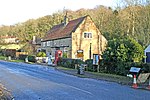Brandsby-cum-Stearsby

Brandsby-cum-Stearsby is a civil parish in the Hambleton district of North Yorkshire, England, with a population of 234 (2001 census), increasing to 383 at the 2011 Census and including Dalby-cum-Skewsby and Yearsley. It includes the villages of Brandsby (which has a separate article) and Stearsby. There are five scheduled ancient monuments in the parish, all round barrows: Round barrow 300m south of Barhouse Farm at grid reference SE587719 Round barrow 450m north-east of Hagg Farm grid reference SE62347199 Round barrow 300m east of Warren House grid reference SE60507316 Round barrow 150m south of Warren House grid reference SE60187303 Round barrow 300m west of Quarry House grid reference SE60587285
Excerpt from the Wikipedia article Brandsby-cum-Stearsby (License: CC BY-SA 3.0, Authors, Images).Brandsby-cum-Stearsby
Snargate Hill,
Geographical coordinates (GPS) Address Nearby Places Show on map
Geographical coordinates (GPS)
| Latitude | Longitude |
|---|---|
| N 54.139 ° | E -1.077 ° |
Address
Snargate Hill
Snargate Hill
YO61 4SP , Brandsby-cum-Stearsby
England, United Kingdom
Open on Google Maps








